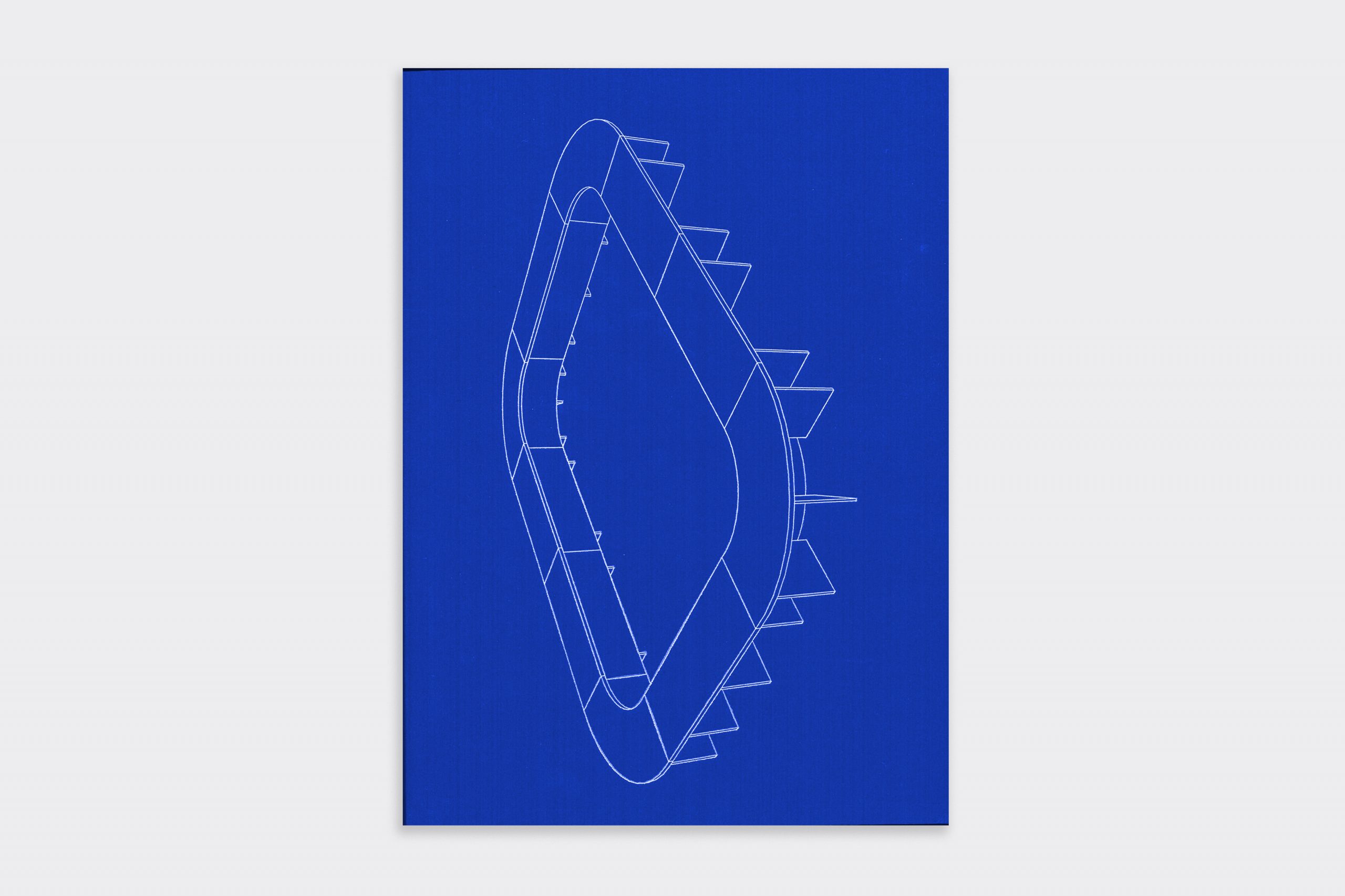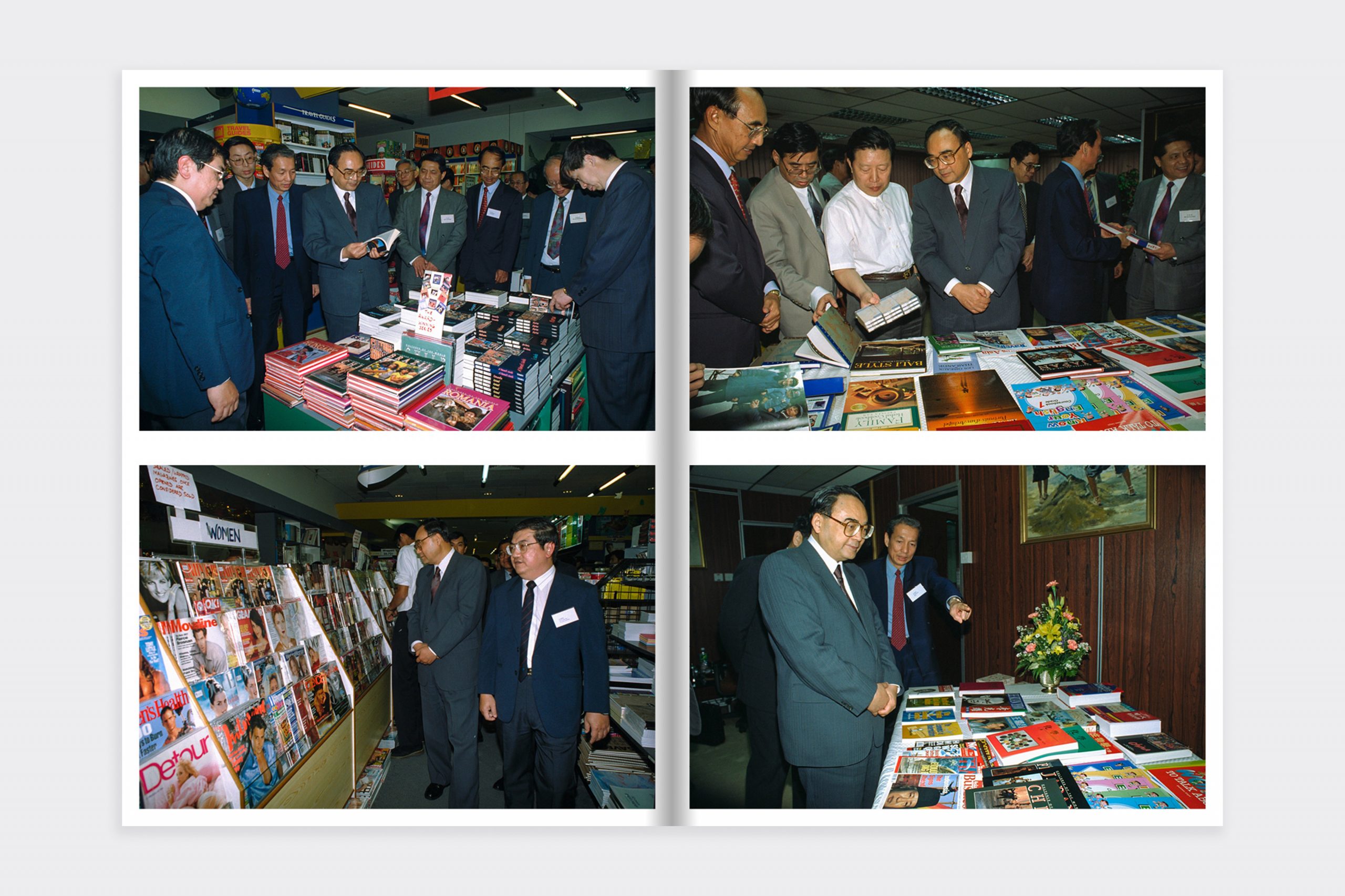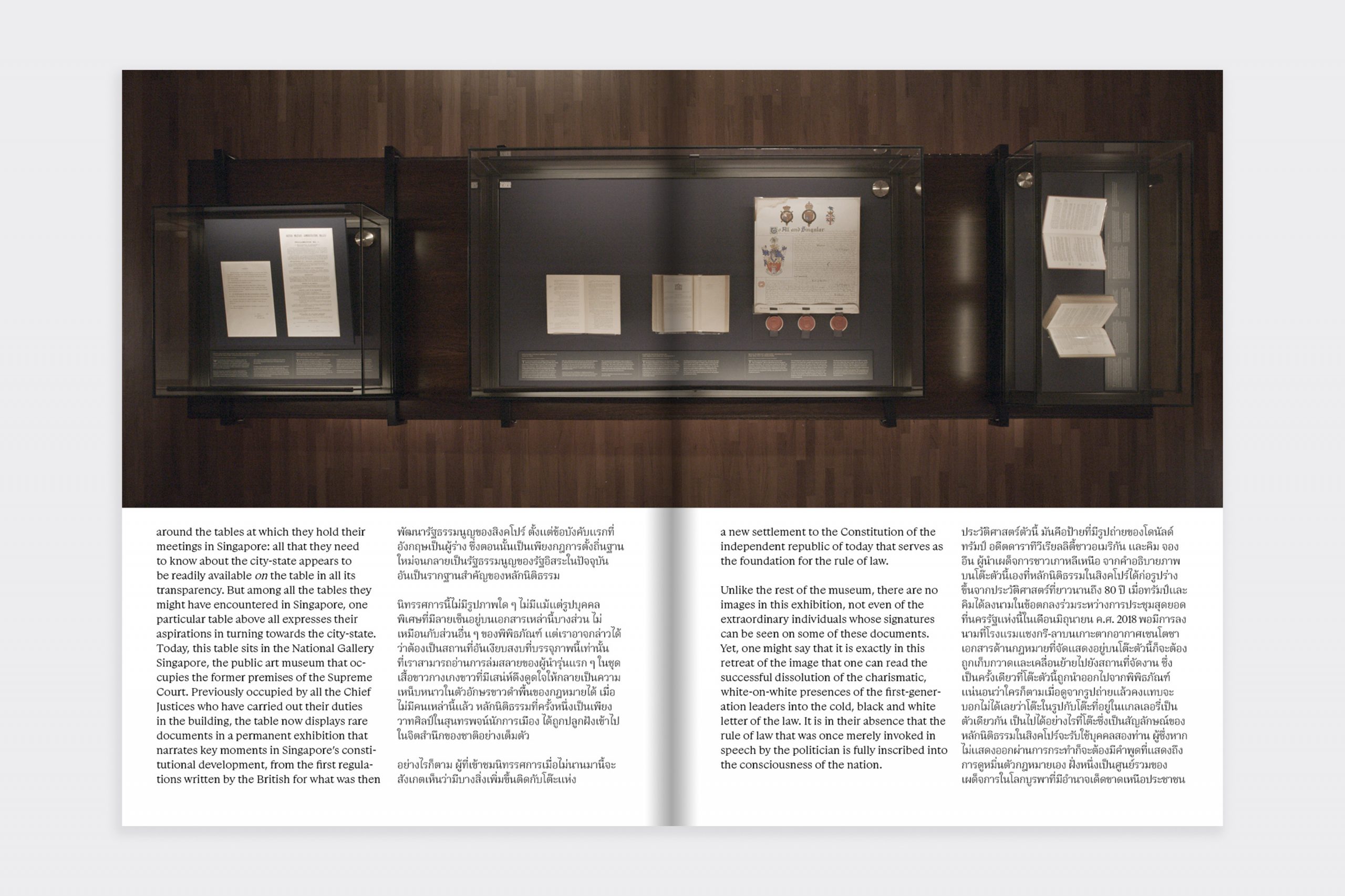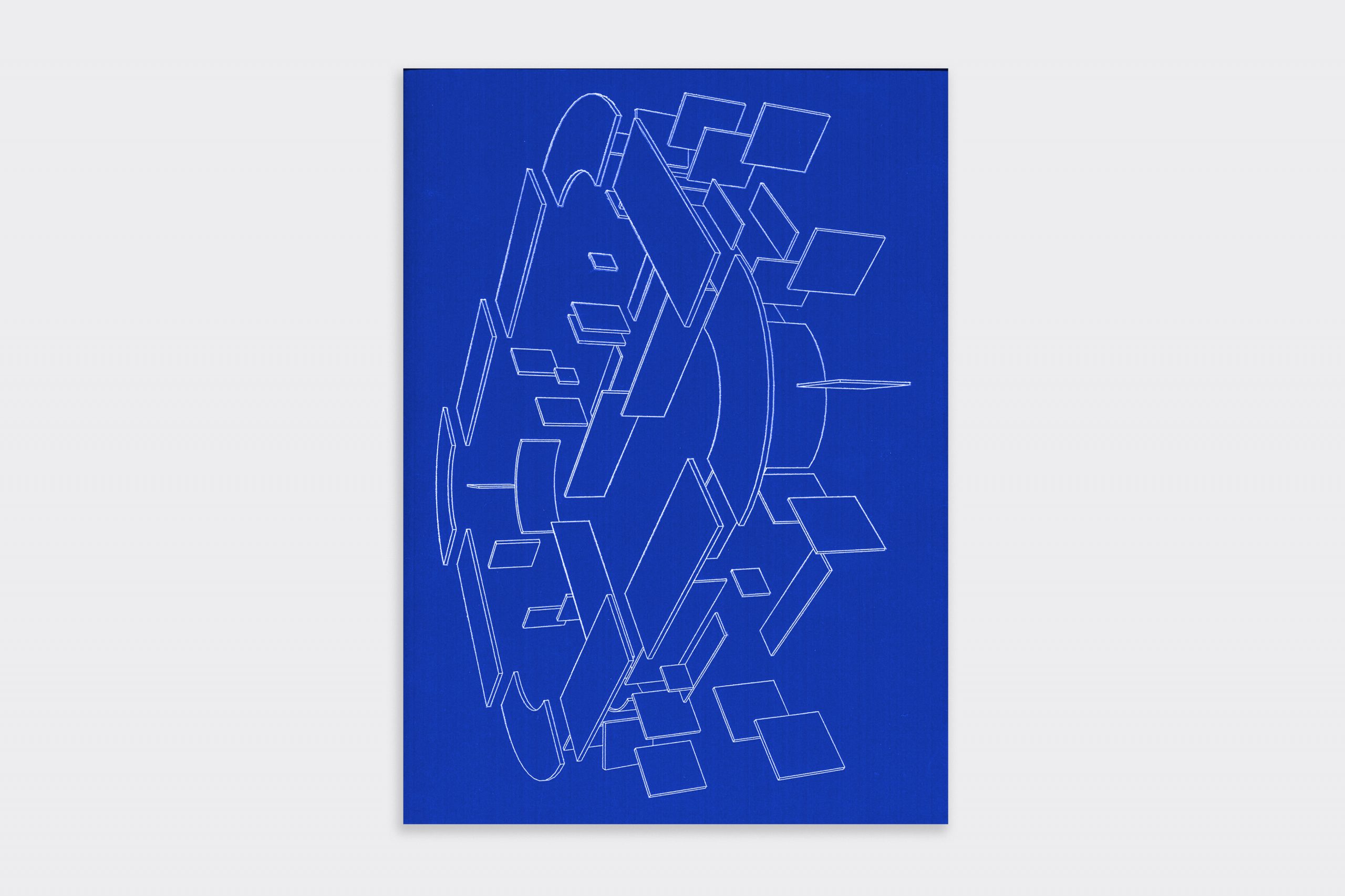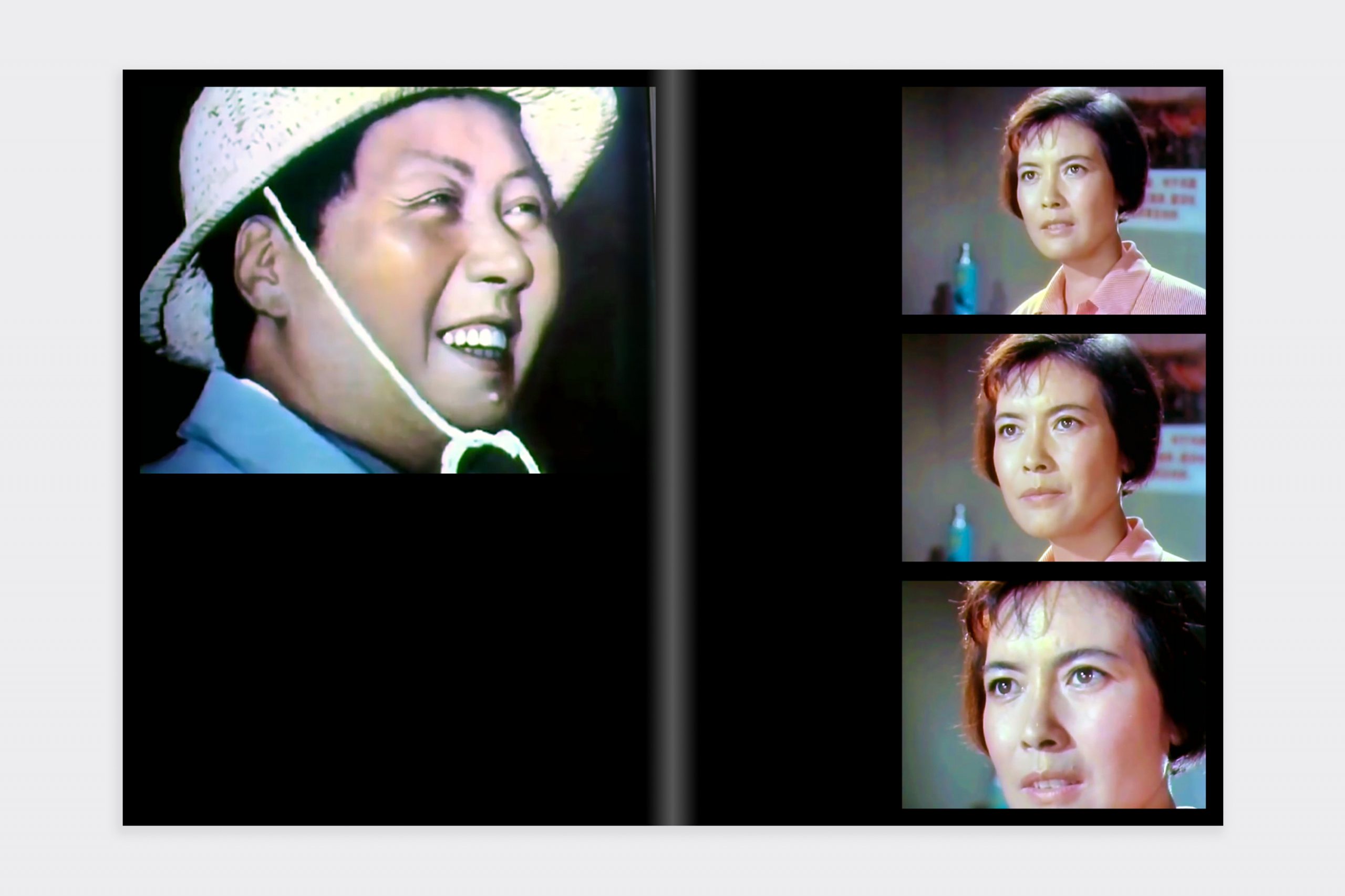Tables | Factories
Ho Rui An
English / Thai
2022
Published by BANGKOK CITYCITY GALLERY
Printed by Parbpim Printing
Bangkok, Thailand
16 x 22 cm, 152 pages, color, offset, autobind, soft cover with silver foil stamp
Edition of 700
The process of preparing this book began with looking at photographs of large meeting tables around which Chinese and Singaporean public officials gathered during the many Chinese government study missions to Singapore throughout the 1990s. While such images might seem unremarkable today, the appearance of former revolutionaries of the Maoist era as sedentary technocrats marks the historic emergence of a distinct political imaginary in a time when “the economy” was displacing class struggle as the primary subject of governance in China.
It was at the table that these technocrats, having extricated themselves from the masses, devised the concept of the socialist market economy to frame the economic reforms that were launched by Deng Xiaoping in 1978. As they insisted on the compatibility of the market economy with the prevailing socialist social contract, the reformers articulated their turn towards the market as a decision informed not by the “invisible” manner through which the market allocates its resources, but by the assumed transparency of its information flows, which they believed would make visible what the party-state had been previously unable to see.
Yet, to the extent that this process of “seeking truth from facts”, as the reformers put it, is founded upon a set of separations—the party-state from the masses, information from ideology, the economic from the political—what ultimately underwrites the total visibility apparently provided by the table is the concealment of that which must not be allowed to appear as information in order for the logic of the market to obtain: the exploitation of labour.
It is on this basis that the factory can be construed as the table’s forgotten origin and impenetrable interior, and the gate that circumscribes the compound the limit of the market’s capacity for making things visible. Designed to spatially contain industrial labour and hide their exploitation from the public sphere, the factory gate is as close as the technocrat would get, as seen during the factory’s opening ceremony, to the world of labour under a capitalist mode of production. In thus proposing a convergence between tables and factories and examining their respective regimes of (in)visibility across the contexts of Singapore and Reform-era China, this collection of images and texts seeks to understand how the seemingly disparate worlds centred around these two objects in fact call forth each other to produce our deeply unsettled contemporary condition—one where the recognition that accrues to visibility has replaced freedom from exploitation as the most that the people can ever demand after the revolution’s untimely end.
โต๊ะ | โรงงาน
โฮ รุย อัน
ภาษาอังกฤษ / ภาษาไทย
2565
จัดทำโดย บางกอก ซิตี้ซิตี้ แกลเลอรี่
พิมพ์โดย โรงพิมพ์ภาพพิมพ์
กรุงเทพฯ, ไทย
16 x 22 ซม, 152 หน้า, สี, ออฟเซ็ท, ออโต้บาย, ปกอ่อนตกแต่งฟอล์ยเงิน
พิมพ์จำนวน 700 เล่ม
กระบวนการในการจัดทำหนังสือเล่มนี้ เริ่มจากการดูภาพถ่ายของโต๊ะประชุมขนาดใหญ่ที่มีเจ้าหน้าที่รัฐทั้งจากจีนและสิงคโปร์นั่งเรียงล้อมวงประชุมร่วมกันในระหว่างภารกิจการมาศึกษาดูงานหลายครั้งของรัฐบาลจีนในช่วงทศวรรษที่ 1990 ขณะที่ภาพเหล่านี้อาจดูเหมือนภาพธรรมดาๆ ในเวลาปัจจุบัน แต่การปรากฏตัวของเหล่านักปฏิวัติในยุคเหมาในฐานะเทคโนแครตนั้น นับเป็นการเริ่มต้นครั้งประวัติการณ์ของมโนภาพทางการเมืองอันโดดเด่น ในช่วงเวลาที่ “เศรษฐกิจ” เข้าแทนที่การต่อสู้ทางชนชั้นในฐานะวาระหลักในการปกครองของจีน
บนโต๊ะตัวนี้เอง ที่กลุ่มเทคโนแครตผู้ได้ปลดแอกตนเองออกจากมวลชน ได้ก่อกำเนิดแนวคิดเศรษฐกิจตลาดสังคมนิยมเพื่อวางกรอบการปฏิรูปเศรษฐกิจที่ เติ้ง เสี่ยวผิง ได้ประกาศการปฏิรูปดังกล่าวใน ค.ศ. 1978 อย่างที่พวกเขายืนยันว่าเศรษฐกิจแบบตลาดจะเข้ากันได้กับสัญญาประชาคมที่มีอยู่ กลุ่มนักปฏิรูปชี้ชัดถึงการหันไปสู่ตลาดในฐานะการตัดสินใจที่ไม่ได้เกิดจากวิธีการที่ “มองไม่เห็น” ซึ่งตลาดใช้จัดสรรปันส่วนทรัพยากรที่มีอยู่ หากทว่า ตัดสินใจโดยสันนิษฐานบนความโปร่งใสที่คาดว่าจะเห็นจากการไหลเวียนของข้อมูล ซึ่งพวกเขาเชื่อว่าจะช่วยเปิดเผยสิ่งที่รัฐในระบบพรรคการเมืองแบบพรรคเดียวมองไม่เห็นมาก่อน
กระนั้นแล้ว เท่าที่กระบวนการของ “การแสวงหาความจริงจากข้อเท็จจริง” ตามที่กลุ่มนักปฏิรูปว่าไว้นั้น เกิดขึ้นบนพื้นฐานของการแบ่งแยกในหลายมิติ กล่าวคือ ในมิติการแบ่งแยกรัฐแบบพรรคการเมืองเดียวออกจากมวลชน แบ่งแยกข้อมูลออกจากอุดมการณ์ แบ่งแยกเศรษฐกิจออกจากการเมือง ท้ายที่สุดแล้ว สิ่งที่รับประกันการมองเห็นโดยรวมที่โต๊ะตัวนี้มอบให้ คือการปกปิดสิ่งที่จะไม่ได้รับอนุญาตให้ปรากฏเป็นข้อมูลเพื่อให้ตรรกะของตลาดยังได้รับการแสวงหาผลประโยชน์จากแรงงาน
บนพื้นฐานแนวคิดนี้เอง ที่โรงงานสามารถถูกตีความได้ว่าเป็นที่มาที่ถูกลืมเลือนของโต๊ะและเป็นพื้นที่ภายในที่ไม่อาจเข้าแทรกแซงได้ และประตูโรงงานที่วางกรอบพื้นที่ภายในโรงงานนั้น คือขีดจำกัดของศักยภาพของตลาดในการทำสิ่งต่าง ๆ ให้เป็นที่ประจักษ์ต่อสายตา ประตูโรงงานที่ถูกออกแบบมาเพื่อจำกัดพื้นที่แรงงานในอุตสาหกรรมและซุกซ่อนการแสวงหาผลประโยชน์จากแรงงานจากสายตาโลกสาธารณะ นับเป็นจุดที่ใกล้ที่สุดที่เทคโนแครตจะเข้าถึงโลกของแรงงานภายใต้แนวคิดการผลิตแบบทุนนิยมได้ ดังที่เห็นได้ในระหว่างพิธีเปิดโรงงาน ดังนั้น ในการนำเสนอเรื่องราวผนวกผสานกันระหว่างโต๊ะและโรงงาน รวมทั้งการวิเคราะห์ระบอบ (อ) ทัศนิวิสัยของทั้งสิ่งทั้งสองในบริบทของสิงคโปร์และจีนในยุคปฏิรูป ภาพถ่ายและข้อเขียนเหล่านี้พยายามทำความเข้าใจว่าโลกที่ดูเหมือนไม่ต่างกันที่เกิดขึ้นบนและภายในสิ่งทั้งสองนี้ แท้จริงแล้วเรียกร้องต่อกันและกันในการผลิตสร้างสภาวะร่วมสมัยไร้ความมั่นคงของเรา สภาวะที่สำนึกรับรู้ทวีมากขึ้นจนความมองเห็นได้เข้าแทนที่เสรีภาพจากการแสวงหาผลประโยชน์ ในฐานะสิ่งที่ประชาชนสามารถเรียกร้องได้มากที่สุดแล้วหลังการปฏิวัติได้สิ้นสุดลงก่อนเวลาอันสมควร
